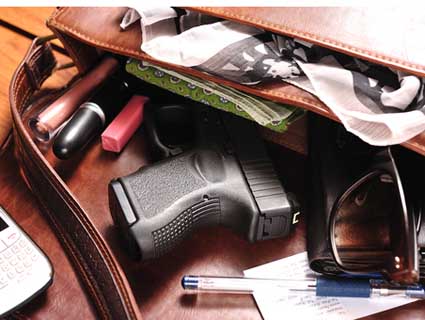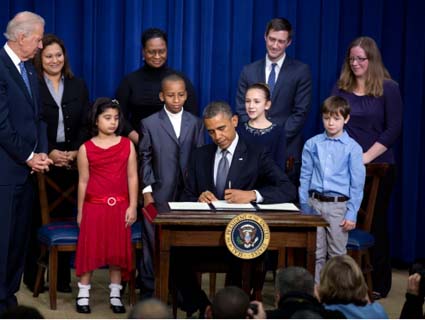
<a href="http://www.shutterstock.com/pic-85644310/stock-photo-boy-wearing-handcuffs.html">iingles</a>/Shutterstock
This story first appeared on the website of the Center for Public Integrity.
In post-Newtown America, those with power say they must act to prevent another massacre of innocents.
The Obama administration wants stiffer gun control, and $150 million to help schools hire up to 1,000 more on-campus police or counselors, or purchase security technology. State legislators are considering shifting millions of dollars around to help schools hire more police. Some locals aren’t waiting: The 5,500-resident town of Jordan, Minnesota, has moved its entire eight-officer police force into schools.
“The only way to stop a bad guy with a gun is with a good guy with a gun,” National Rifle Association executive vice president Wayne LaPierre said after a young man shot his way into his former grammar school on December 14 in Newtown, Connecticut, and killed 20 first-graders and 6 educators.
With the new year, the NRA has been flexing its political muscle, lobbying states not just to hire more school police—under the group’s National School Shield project—but also to pass laws allowing teachers or other staff to bring licensed guns to school to defend their students and themselves.
Beyond the headlines, though, the push for more cops or other armed security personnel in schools is running headlong into another movement that’s been quietly growing in states as diverse as Mississippi, New York, Utah, Texas, and California. It’s a push to get police out of schools, or at least to end their involvement in routine discipline matters that principals and parents used to address without involvement from law enforcement officers.
Civil rights groups and juvenile court judges—and even some officials within the Obama administration—argue that because the ranks of police began growing in schools in the late 1990s, the criminal justice system’s involvement in student discipline has gotten entirely out of hand in some communities. That has put students, especially ethnic minorities, on a path to failure, they say—the so-called school-to-prison pipeline.
In Los Angeles, for example, scores of students, most Latino or black and many just 11 or 12 years old, have been ticketed by school officers for minor infractions often categorized as disturbing the peace. In Austin, Texas, a 12-year-old was forced to court for spraying on perfume in class. In DeSoto County, Mississippi, officers and a school district were sued after a bus surveillance video—seen in part by a reporter—revealed officers unjustifiably arresting black students, the suit alleged, and threatening others with a “a bullet between the eyes.”
Optimists—Education Secretary Arne Duncan among them—say cops in schools are not an either/or proposition: careful training, they say, will ensure that school police deployed in the wake of Newtown protect, rather than intimidate, students.
But many civil rights advocates are worried. They say plenty of cities and states are only beginning to come to grips with allegations that schools, and school-based police, have unjustifiably sent students into the criminal-justice system.
A Push for Security
Police presence in schools has been growing for years. The number of full-time city police officers assigned to schools increased nearly 40 percent from 1997 to 2007, according to the US Justice Department. One infamous incident fueling that rise was the 1999 massacre of 12 students and a teacher by two students at Columbine High School in suburban Denver.
After Newtown, though, an intense new round of calls for more cops in schools has echoed through small towns and big cities nationwide.
The state legislative delegation of Broward County, Florida, for example, quickly approved a proposal in January—it must now be approved by state legislators—that could allow increases in property taxes in Broward to pay for more school police, at an annual cost of up to $130,000 per officer.
The National Conference of State Legislatures, a nonpartisan research group, told the Center for Public Integrity that in February it began tracking a flurry of school-security legislation in more than 20 states.
Since January, two school-security bills in Mississippi, publicly backed by NRA representatives, have been moving fast through the Statehouse. One bill would set up a $7.5 million school-security fund to offer Mississippi schools $10,000 matching grants to hire police. The other bill, which Mississippi’s House of Representatives approved February 13, would allow districts to designate teachers or other school staff to act as a secret defense force in the event of an attack. Volunteers would take their own licensed, concealed weapons to school. The House rejected a proposal to require psychological evaluations of those designated by districts.
Alabama legislators are considering creating a lottery to pay for a $20 million plan to put police officers in every school. Indiana lawmakers are weighing a proposal to set aside $10 million to offer grants to schools to hire local police to post in schools. States where legislators have introduced proposals to allow designated teachers or other school staff to be armed include Alabama, Arizona, Georgia, Illinois, Maryland, Oklahoma and South Carolina. Texas and Utah already allow licensed gun owners to take weapons onto campuses under certain circumstances. Legislators in those states are discussing ideas for supporting school staff who want to have weapons at school for defense.
The NRA isn’t alone in trying to influence the debate. The Alabama-based National Association of School Resource Officers, or NASRO, is pushing for more law enforcement in schools. NASRO opposes arming teachers. Stung by criticism of resource officers, the nonprofit NASRO vigorously disputes the idea that a school-to-prison pipeline is pervasive. In “To Protect and Educate“, a report issued last October, NASRO said: “Attacks against the school resource officer are superficial and polemical.” On a Facebook page, NASRO has posted multiple news reports about school resource officers foiling violent acts by students.
Kevin Quinn, president of NASRO, said in an interview that NASRO regards cases of abuses by school police to be isolated. “The No. 1 way to combat that is training,” said Quinn, a school resource officer in the Phoenix area. Quinn agreed with civil rights advocates that some school districts have become too reliant on police to enforce discipline. Over the last decade, more schools have adopted “zero tolerance” polices, not just for guns or other weapons or drugs, but for behavior that’s seen as disorderly or defiant.
“The problem,” Quinn said, “is the school at times says, ‘Oh, we’ve got a cop. Let him take care of things.'”
Out of Hand?
Chief Juvenile Court Judge Steven Teske, of Clayton County, Georgia, is not against police in schools, but firmly believes that a school-to-prison pipeline exists. When Teske took the bench in 1999 in his Atlanta suburb, which is 66 percent black, one-third of the cases in his court were kids referred from schools. By 2004, he said, 92 percent of the 1,400 cases in his court came from schools, mostly for alleged disruption and disorderly conduct.
Lt. Francisco Romero, Clayton’s school resource officer at the time, told the Center for Public Integrity that he was disturbed to discover that one year he arrested more people—students—than any other officer in Clayton. Fed up, Teske called together school and police leaders and hammered out a protocol requiring counseling and clear warnings before students were sent to court. Teske credits the protocol with improving relationships between students and police, and driving down juvenile felonies by 51 percent and increasing graduation rates by 24 percent.
“If police are placed on campus without written protocols defining their role, the results will be disastrous—just as removing existing police from campus can have unintended consequences,” Teske wrote in the publication Youth Today after the Newtown killings.
Judith Browne Dianis, codirector of the Advancement Project, a national civil rights group urging discipline reforms, said that after the 1999 Columbine shootings, police citations of students in the city of Denver skyrocketed. Student referrals to police increased by 71 percent between 2000 and 2004. Only 7 percent of referrals to law enforcement from Denver’s schools, whose students are mostly nonwhite, were for serious offenses such as carrying a weapon.
In February, Denver school and police officials signed an agreement that obliges school police to “de-escalate” conflicts, attend training sessions on child psychology and embrace “restorative justice,” which requires students to sit down and resolve problems outside the criminal court system. Dianis, whose group collaborated on the Denver agreement, hopes Denver’s decision influences other jurisdictions as they weigh putting more police in schools.
In Los Angeles—home to the country’s largest school police force—school leaders, judges, police and civil rights activists have been holding a series of meetings to work toward a protocol for student citations and arrests.
The Center for Public Integrity analyzed Los Angeles Unified School District Police records and found that from 2009 through 2011, officers issued about 10,000 tickets a year to students, mostly in low-income neighborhoods. More than 40 percent of citations, the Center also found, went to students 14 or younger in schools that parents said were more heavily policed. Juvenile court judges complained about a parade of children in court for infractions better dealt with at school.
Reconciling such findings with current security concerns is difficult, concedes Dennis Parker, director of the American Civil Liberties Union’s Racial Justice Program. Parker said it sounds “callous” to protest placing more police in schools after Newtown, a town that immediately after the December massacre assigned officers to guard schools. But one of the ACLU’s high-profile lawsuits involving schools right now accuses New York City police—whose ranks have grown in schools by 73 percent since 1998—of violating students’ rights by using excessive force, handcuffing and arrests in response to infractions such as drawing on a desk.
“It’s very likely that officers dealing with children in Newtown will deal with them differently than children in Harlem,” Parker said. “It is likely to be more of an ‘Officer Joe, your friend,’ who is there than someone who tells you to stand up against a wall and spread your legs.”
New York City police administrators insist that officers have lowered crime in schools and say that the ACLU “talks about arrests in schools but, conveniently, not crimes.”
On December 13, the day before the Newtown killings, Parker’s Racial Justice Program filed a class-action lawsuit on behalf of ethnic-minority students allegedly rounded up by police in December 2010 at West High School in Salt Lake City. The school district and the Salt Lake City police said they could not comment, because of a policy not to discuss pending litigation.
The ACLU suit says that plaintiff Kevin Winston’s son, Kaleb, was 14 when two plainclothes officers ushered the student, who is half-black, into a room and falsely accused him of gang membership and graffiti, or “tagging.” An officer allegedly grabbed Kaleb’s arm, told him, “Quit acting tough,” and searched his backpack. The suit says that officers forced Kaleb, who has no juvenile record, to pose for a photo—to put in a gang database—holding a sign with his name and the word “tagger” on it.
After he was released, the suit says, Kaleb was shaken, called his parents and asked to go home. The suit says that when Lisa Winston, his mother, protested what had happened officers told her the sweep was done because of “a problem with the Mexicans.”
On March 1, the Salt Lake defendants filed a court document admitting that police had entered the school and questioned students. But in the documents, they deny that they “acted unconstitutionally” and deny that they referred to a problem with Mexicans.
In February, a similar suit filed by the ACLU of Southern California in 2011 was partially settled on behalf of 56 students at Hoover High School in Glendale, California, near Los Angeles. The suit says that school administrators and Glendale police interrogated Latino and other minority students, and made them pose for mock mug shots.
Glendale police Sgt. Thomas Lorenz told the Associated Press that the actions were an attempt to educate students on the peril of gangs. He denied that officers’ methods amounted to racial profiling. “I’ve never been in trouble, and it was confusing, terrifying and humiliating,” said Ashley Flores, who was 16 when the incident happened. The settlement requires Glendale police and school officials to notify parents if students are to be questioned on campus. To ensure that officers uphold students’ rights, they will be trained to avoid racial profiling.
Walking the Line
Michael Nash, presiding juvenile court judge in Los Angeles County, said in an interview that it’s hard to argue against placing police in schools—if they stay out of discipline matters.
As president of the National Council of Juvenile and Family Court Judges, Nash sent a strongly worded letter to the Obama administration on January 14, responding to the administration’s call for ideas on school safety. “Research shows that aggressive security measures produce alienation and mistrust among students, which, in turn, can disrupt the learning environment,” the letter said. “Such restrictive environments may actually lead to violence, thus jeopardizing, instead of promoting, school safety.”
A student’s odds of dropping out of high school quadruple with a first-time court appearance, Nash wrote. Last summer, the judges’ council began a national campaign “to support school engagement and reduce school expulsion.” Putting more armed personnel into schools, Nash said, could prove “counterproductive” to this effort.
On January 16, the White House announced it would seek congressional authorization for a $385 million school violence prevention package for fiscal year 2014. A spokesman for House Speaker John Boehner, (R-Ohio) said the president’s proposals would go to appropriate committees. A Washington Post poll in January suggested that the recommendation for hiring more school police would face little opposition. The poll found that 55 percent of the public would even support a law to put an armed guard in every school.
A centerpiece of the White House proposal is the request for $150 million to help schools hire up to 1,000 new police. But in nod to concerns like Nash’s, schools could also use grants to hire counselors and school psychologists.
The administration also proposes $50 million to help 8,000 schools create safer and more “nurturing” atmospheres at schools. Another $25 million would be used to help schools struggling with “pervasive violence,” and $30 million would be for one-time grants for states to help schools develop emergency plans.
A total of $130 million would be for helping schools adopt conflict-resolution programs and improving early detection of student mental health problems.
In a January media call, Education secretary Duncan was asked to respond to concerns that more police would lead to misguided crackdowns on students. “There’s no reason why additional school resources have to drive up the schoolhouse-to-jailhouse pipeline,” Duncan said. “Execution is really important—taking time train people in a really thoughtful way.” The Department of Justice, he said, will be in on that training.
Duncan is no stranger to controversy over school discipline. Between 2009 and 2012, the Department of Education launched more than 20 investigations into allegations in school districts that minority students were punished more harshly than white pupils for the same violations of school rules. Duncan’s department aims to amicably reach agreements with districts to change discipline practices. Last year, the department also released an unprecedented analysisof national school data showing that black students, 18 percent of the sample, represented 42 percent of students referred to law enforcement.
These issues have been aired in two Congressional hearings since December. In a February appearance before the House Education and the Workforce Committee, NASRO’s executive director Mo Canady said the role of school resource officers is as “a trusted adult that a student can come to for information, for guidance.” He also said officers should leave “formal discipline” to educators.
Searching for Balance
In Texas, police involvement in routine school discipline is a hot topic. On February 20, the NAACP Legal Defense Fund and the National Youth Law Center filed a complaint with the US Department of Education’s Office for Civil Rights. The complaint is based on citation records showing that black students in the Bryan Independent School District, 100 miles north of Houston, are given municipal court summonses in numbers far greater than the proportion of school enrollment they represent.
Black students represent almost 22 percent of the 15,500-pupil Bryan district but were given more than half of all Class C misdemeanor tickets issued to students for “disruption of class” and “disorderly conduct,” according to the complaint. The complaint also says that staff of Texas Appleseed, a public-interest law group, observed Bryan students in court, including a 13-year-old whose teacher overheard him use profanity before class started and sent him to the principal, who, in turn, asked an officer to issue a ticket.
In a statement, the Bryan district said it would welcome “a dialogue” with federal education investigators. The citation numbers alleged in the complaint “were certainly no surprise to us, and we have been proactive in taking measures to address the issue,” the district said. “We hope the measures we are taking to support our minority students will result in a more positive outcome.”
Texas state Democratic Sen. John Whitmire, chairman of the Criminal Justice Committee, says it’s time to stop these tickets, which can cost families hundreds of dollars and end up creating a criminal record for the student. He said legislators will have to search for a balance between security and smart use of school police. The Houston Democrat hopes to pass a bill this year to stop ticketing for basic misbehavior, and require alternatives for students before schools send them to court.
It used to be a “comforting” to see a police officer at school, Whitmire said. Then cash-strapped schools shed counselors, police stepped in as enforcers, and Texas courts, he said, began to expect revenue from student tickets. “These police departments have grown and grown, and they have to justify their budgets,” Whitmire added. “They’ve even asked for legislation to be able to go [do enforcement] outside schools.”
But in response to Newtown, Whitmire is cosponsoring another proposal with state Sen. Tommy Williams, a Republican from The Woodlands, to allow districts to try to raise taxes or other revenue to hire more school police or buy security technology. He’d prefer adding police to arming teachers, Whitmire said, but he’ll “make damn sure,” he said, that more police doesn’t lead to more tickets.
Mississippi state Democratic Rep. John Hines Sr. is concerned about safety, too. But he’s also trying to get fellow legislators more interested in allegations of a school-to-prison pipeline in his state. In January, Hines, who chairs the House Youth and Family Affairs Committee, held a state public hearing to discuss the “Handcuffs on Success” report issued that month by the Advancement Project, the ACLU of Mississippi, the Mississippi State Conference of the NAACP, and the Mississippi Coalition for the Prevention of Schoolhouse to Jailhouse.
The report notes that the Jackson Public Schools District was sued in 2011 in connection to allegations that its students were handcuffed to railings for dress-code violations or refusing to do their schoolwork. The district settled the suit last May with an agreement to stop handcuffing children younger than 13, and to only handcuff older students when they are accused of a crime. A review of Jackson police records shows, according to “Handcuffs on Success,” that 96 percent of student arrests at schools in 2010-11 were for misdemeanors, most for disorderly conduct. Only 4 percent were for suspected felonies.
Hines said he’s also troubled by a lawsuit the Department of Justice filed last October against Meridian, Mississippi (PDF), alleging that students there “are regularly and repeatedly handcuffed and arrested in school and incarcerated for days at a time without a probable cause hearing.”
“I want kids safe,” Hines said. “I don’t want people coming off the street or an enraged child shooting people. But I don’t want lots of people all strapped up with guns at our schools either.”
Republican Lester “Bubba” Carpenter, who also serves in Mississippi’s House, is sponsoring the proposal to allow districts to designate teachers or employees as a secret “marshals” with permission to bring their own licensed, concealed weapons to school. Mississippi is a “pretty poor state,” Carpenter said, so the idea is cost-effective. He’s not worried that teachers will panic and shoot in haste. “I think they’re smart enough individuals,” Carpenter said. “We trust them with our children every day.”
But Carpenter also supports the proposal to set aside $7.5 million so that schools can apply for $10,000 matching grants to hire police officers. “I’ll vote for both of them,” Carpenter said of the proposals. “You can’t get enough security at schools.”
Carpenter said he wasn’t that familiar with the allegations of police excesses alleged in the ACLU and Justice Department lawsuits, or the “Handcuffs on Success” report. “You’re always going to have a bad apple,” he said.
The Center for Public Integrity is a nonprofit, independent investigative news outlet. For more of its stories on this topic go to publicintegrity.org














